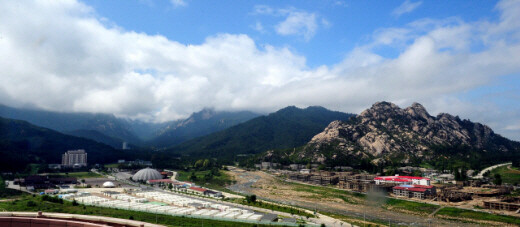hankyoreh
Links to other country sites 다른 나라 사이트 링크
S.Korean government attempts to blocks commercial money to North Korea regarding Mt. Kumgang tourism

Under the justification of preventing suspicions that the costs of the Mt. Kumgang tourism project are being used by North Korea for nuclear development, the South Korean government is reportedly pushing a plan to transform the current method of payment in which North Korea spends the money it receives from the tourism at its own discretion, into one in which there is more transparency about how the money has been used. In particular, the South Korean government does not plan to allow tourism to resume prior to establishing transparency over how the payments are used. Even if the three conditions for restarting the Mt. Kumgang project (an investigation of the death of a South Korean tourist shot at Mt. Kumgang, implementation of measures to prevent a recurrence, and a guarantee of tourist safety) are met, observers are pointing out that this could become yet another hurdle to restarting the tourism project.
A key government official said Wednesday that even if the three conditions for restarting the Mt. Kumgang tourism project are met, tourism will not resume if funds continue to enter North Korea in cash payments. Another official said it would be difficult to restart the tourism project while maintaining the current payment system as long as there are still suspicions that North Korea is using the funds received from tourism to develop nuclear weapons. He said the tourism project will resume only when a plan is prepared in agreement with North Korea to gain transparency with how the funds are used.
The government’s attitude is in line with a statement given by President Lee Myung-bak in an interview with European news channel EuroNews on July 7, in which he namely said that there are suspicions that the massive aid given to North Korea over the last decade had been used to develop nuclear weapons. A government official said they were unable to block all of the cash entering North Korea from tourists spending money at Mt. Kumgang, but the government has concluded that at least the tourism fees should be transparent. Up until the project was suspended last July, Hyundai Asan, the company that operates the Mt. Kumgang tourism project, had sent North Korea 30 dollars per person for same-day tours, 48 dollars for two-day, one-night tours and 80 dollars for three-day, two-night tours. In total, Hyundai Asan had given North Korea an estimated 15 million dollars per year.
Reportedly under consideration is a plan to pay North Korea not in cash but in goods such as grain or sugar, or to open up an escrow account that would limit North Korea to transferring money for the import of specific non-military-use items.
Along with criticism that this proposal runs counter to international practice, however, there is also criticism that the South Korean government is putting up yet another barrier beyond the “three conditions” to restarting Mt. Kumgang tourism. This runs counter to a statement on Sept. 29 by Vice Unification Minister Hong Yang-ho, who said the North Korea nuclear issue and Mt. Kumgang tourism are not connected and that the government’s position is that there has not been a change in the three conditions.
An expert on economic cooperation with North Korea said the Mt. Kumgang tourism project is a commercial deal that has nothing to do with United Nations sanctions on North Korea, and restricting the method of payment using the political logic of trying to block money from being used for nuclear development runs counter to international practice. He said North Korea would likely interpret the move as an intention by the South Korean government to continue to apply pressure on North Korea by suspending the project.
Please direct questions or comments to [englishhani@hani.co.kr]
Editorial・opinion
![[Column] Has Korea, too, crossed the Rubicon on China? [Column] Has Korea, too, crossed the Rubicon on China?](https://flexible.img.hani.co.kr/flexible/normal/500/300/imgdb/original/2024/0419/9317135153409185.jpg) [Column] Has Korea, too, crossed the Rubicon on China?
[Column] Has Korea, too, crossed the Rubicon on China?![[Correspondent’s column] In Japan’s alliance with US, echoes of its past alliances with UK [Correspondent’s column] In Japan’s alliance with US, echoes of its past alliances with UK](https://flexible.img.hani.co.kr/flexible/normal/500/300/imgdb/original/2024/0419/2317135166563519.jpg) [Correspondent’s column] In Japan’s alliance with US, echoes of its past alliances with UK
[Correspondent’s column] In Japan’s alliance with US, echoes of its past alliances with UK- [Editorial] Does Yoon think the Korean public is wrong?
- [Editorial] As it bolsters its alliance with US, Japan must be accountable for past
- [Guest essay] Amending the Constitution is Yoon’s key to leaving office in public’s good graces
- [Editorial] 10 years on, lessons of Sewol tragedy must never be forgotten
- [Column] A death blow to Korea’s prosecutor politics
- [Correspondent’s column] The US and the end of Japanese pacifism
- [Guest essay] How Korea turned its trainee doctors into monsters
- [Guest essay] As someone who helped forge Seoul-Moscow ties, their status today troubles me
Most viewed articles
- 1[Column] The clock is ticking for Korea’s first lady
- 2Samsung barricades office as unionized workers strike for better conditions
- 3S. Korea, Japan reaffirm commitment to strengthening trilateral ties with US
- 4[News analysis] After elections, prosecutorial reform will likely make legislative agenda
- 5[Editorial] When the choice is kids or career, Korea will never overcome birth rate woes
- 6Japan officially says compensation of Korean forced laborers isn’t its responsibility
- 7[Editorial] As it bolsters its alliance with US, Japan must be accountable for past
- 8Why Israel isn’t hitting Iran with immediate retaliation
- 9[Column] Has Korea, too, crossed the Rubicon on China?
- 10All eyes on Xiaomi after it pulls off EV that Apple couldn’t